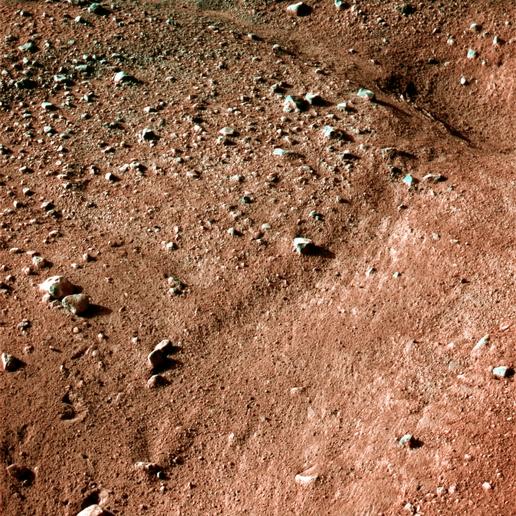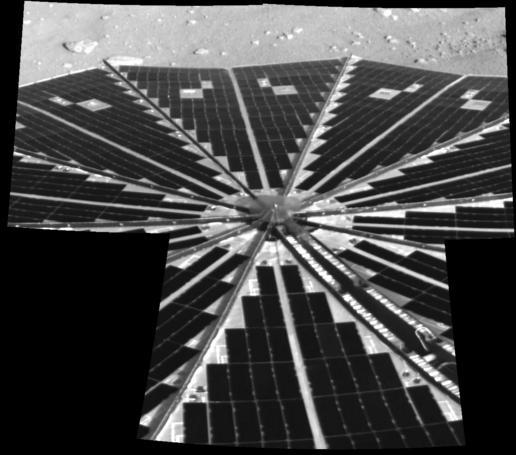NASA's Phoenix spacecraft that landed on Mars tonight transmitted data and images to Earth proving that it is in good condition after the first successful landing of a spacecraft in the polar regions of Mars

The first images broadcast by Phoenix also provide a glimpse of the valley's flat floor, which is expected to be a water-rich permafrost area that will be easily accessible by the lander's robotic arm. The landing ends a journey of 680 million kilometers, and begins a three-month mission during which the scientists will use instruments to "taste" and "smell" the soil and ice in the South Pole area.
"As expected, the area is empty of rocks, we see the polygons we saw from space, we don't see ice on the surface, but we believe that it will be found below the surface. It looks wonderful," said Peter Smith of the University of Arizona in Tucson, principal investigator of the Phoenix mission.
The radio signals received on Sunday, 25/5/2008 at 19:53 and 44 seconds EST (02:53:44 Israel time on Monday morning) confirmed that the Phoenix survived the last segment of its journey and landed 15 minutes earlier ( The difference is the time it took for light to travel from Mars). The approval gave the signal to burst into cheers in the control room at NASA's Jet Propulsion Laboratory (JPL) in California, as well as at Lockheed Martin's Space Systems Center in Denver and the University of Arizona.
As planned, the Phoenix began transmitting one minute after landing, focusing its limited battery life on opening the solar array and other important activities. About two hours after landing, and after the solar collectors started charging the batteries, she sent more good news. The first images confirmed that the solar collectors were properly deployed and that the stereoscopic camera and weather station were oriented vertically.

"Seeing these images after a successful landing proves to us that the large and successful team has done a thorough job over the past five years," says JPL's Phoenix Project Manager, Barry Goldstein. "We still have important milestones ahead of us when we start using the 3 meter long robotic arm, not before Thursday.
"Only five of the previous 11 landing attempts on Mars were successful. In space exploration, we expect risks in return for the potential scientific discoveries," says Ed Wheeler, NASA Assistant Administrator in charge of the (Unmanned) Science Mission Administration at NASA Headquarters in Washington.
Phoenix carries scientific instruments designed to assess whether the ice below the surface has ever melted and whether some chemical elements necessary for life are still preserved in the ice floor. These are key questions in trying to assess whether the environment was sympathetic to microbial life. Phoenix will also explore other aspects of the ground and atmosphere using instruments first used on Mars. For example, Canada provided the lander's weather station.
"The transmissions from the Phoenix showed excellent results after testing several components and systems on the spacecraft. The Phoenix is an amazing machine and it was built and flown by an amazing team. During the entire phase of atmospheric entry, descent and landing, performance was smooth and error-free," said Ed Sadibi, Phoenix Program Manager at Lockheed Martin. "The spacecraft remained in contact with Earth during the critical period and we received a lot of data on its health and performance. I am happy to report that she is in good condition," he said.

In the Phoenix spacecraft, NASA used parts built for a spacecraft whose flight was canceled in 2001, following the crash of a similar spacecraft during a landing attempt in 1999. The researchers who proposed the Phoenix mission in 2002 saw the abandoned spacecraft as a resource that could be used for a new scientific opportunity. A few months earlier, the Mars Odyssey spacecraft had discovered an abundance of subsurface water in large areas in the high latitudes. NASA chose Phoenix over 24 other proposals to become the first mission in the Mars Reconnaissance Program, which includes several complementary missions.
The signals confirmed that the Phoenix survived the landing. The Mars Odyssey spacecraft was used as a relay and through it the images were transmitted, which were also helped by the antennas of the NASA Deep Space Network in Goldstone California.
To the home page of the Phoenix spacecraft within the NASA website

10 תגובות
The next world in its fulfillment. Just don't get it dirty with bags and coke cans
An important station in the wise and correct use of the human mind. I hope that he will be accompanied by virtues of modesty, and moral control that is sometimes lacking in rapid scientific progress.
For the exes among us:
I suggest a little more restraint. These are women you once loved. So good - it didn't work out, but why does love have to be replaced by hate?
Also think about the unsympathetic scenario where someone draws your ex's attention to comments on the site and they decide to reply to you.
I don't think that finding water guarantees the existence of life, but as Rami said - it will spread the continued existence of life that will come from Earth
Just exciting
No. Ben-Ner, this must be an unintelligent animal because it reminds me of my (former) girlfriend
Not necessarily finding a life. This will serve as a source of drinking on the manned flight to Mars. We will not have to take a large inventory of fuel, food, drink and air if the raw materials are there.
Wow, a big step in space exploration...
To my dear and enthusiastic Ami Bachar
FYI, not wherever there is water, there is necessarily also life.
So for example you...
..my (former) wife.
Her head is full of water, but life? These, in my opinion, will be found first on Mars.
So it turns out that you are actually right in your enthusiasm. you like it
Just a small correction: in the seventh paragraph it says: "five attempts". five.
I would like to be on Mars if a light microscope. There is life there. If there is water there is life.
very excited,
Ami Bachar